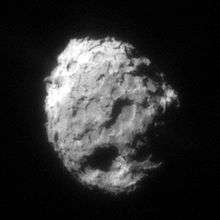16P/Brooks
| Discovery | |
|---|---|
| Discovered by | William Robert Brooks |
| Discovery date | 7 July 1889 |
| Alternative designations |
1889 V; 1896 VI; 1903 V; 1911 I; 1925 IX; 1932 VIII; 1939 VII; 1946 IV; 1953 V; 1960 VI; 1974 I; 1980 IX; 1987 XXIV; 1994 XXIII |
| Orbital characteristics A | |
| Epoch | May 14, 2008 |
| Aphelion | 5.240795 AU |
| Perihelion | 1.466611 AU |
| Semi-major axis | 3.353703 AU |
| Eccentricity | 0.562689 |
| Orbital period | 6.14 a |
| Inclination | 4.2583° |
| Last perihelion |
June 7, 2014[1][2][3] April 12, 2008 |
| Next perihelion | 2021-Apr-18[4] |
16P/Brooks, also known as Brooks 2, is a periodic comet discovered by William Robert Brooks on July 7, 1889, but failed to note any motion. He was able to confirm the discovery the next morning, having seen that the comet had moved north. On August 1, 1889, the famous comet hunter Edward Emerson Barnard discovered two fragments of the comet labeled "B" and "C" located 1 and 4.5 arc minutes away. On August 2, he found another four or five, but these were no longer visible the next day. On August 4, he observed two more objects, labeled "D" and "E". "E" disappeared by the next night and "D" was gone by the next week. Around mid-month, "B" grew large and faint, finally disappearing at the beginning of September. "C" managed to survive until mid-November 1889. No new nuclei were discovered before the apparition ended on January 13, 1891.
The breakup is believed to have been caused by the passage of the comet within Jupiter's Roche limit in 1886, when it spent two days within the orbit of Io. After the discovery apparition, the comet has always been over two magnitudes fainter and no fragments have been seen since 1889.
On 31 December 2016 the comet will pass 0.333 AU from Jupiter then on 3 July 2053 pass 0.247 AU (37,000,000 km; 23,000,000 mi) from Jupiter.[5]
Discovery
William R. Brooks (Geneva, New York) was sweeping for comets on the morning of 1889 July 7, when he found this comet in the southeastern sky within the constellation Aquarius. He described it as faint, with a coma 1 arc minute across and a tail 10 arc minutes long. Although he was unable to detect any motion before sunrise, Brooks quickly found the comet the next morning and noted it had moved slightly northward.
Historical Highlights
- The comet steadily brightened after discovery as it approached both the Sun and Earth. But with the brightening came surprises. On August 1, E. E. Barnard spotted two small, nebulous companions located 1 and 4.5 arc minutes away. The next night, Barnard saw four or five additional nebulous objects, all of which were absent on August 3. On August 4, Barnard saw two more objects. The main nucleus was labelled "A", while those seen on August 1 were labelled "B" and "C". The two objects seen on August 4 were labelled "D" and "E". Companion "E" was not seen after the 4th, while "D" remained visible for about a week. By mid-August "B" suddenly began to grow large and diffuse and it was last seen on September 5. Companion "C" remained observable until November 26, while the main nucleus, "A", remained visible nearly until the time the comet was last seen, which was 1891 January 13.[6]
- Another interesting aspect of this comet's first apparition was that it attained a maximum magnitude of 8. Despite a smaller perihelion distance in the 20th century, the comet has never become brighter than magnitude 10.5. This abnormal brightening, and the fact that the comet split into multiple pieces, is blamed on the planet Jupiter. It would seem the comet passed only 0.001 AU from Jupiter in 1886, actually spending two days within the orbit of Jupiter's moon Io. The gravitational stresses apparently shattered the comet, revealing fresh surfaces to interact with the Sun's radiation at the 1889 apparition. In addition to the comet never having attained this brightness since 1889, no trace of any of the other nuclei have ever been present at later returns.
- Since the comet's discovery apparition, there has been little to get excited about. It has been missed only twice, in 1918 and 1967, when the Sun-Earth-comet geometry was especially bad, and an encounter with Jupiter in 1921, decreased the perihelion distance from 1.96 AU to 1.86 AU.
References
- ↑ Syuichi Nakano (2011-11-01). "16P/Brooks 2 (NK 2146)". OAA Computing and Minor Planet Sections. Retrieved 2012-02-18.
- ↑ Patrick Rocher (2009-03-03). "Note number : 0011 P/Brooks 2 : 16P". Institut de mécanique céleste et de calcul des éphémérides. Retrieved 2012-02-19.
- ↑ 16P/Brooks past, present and future orbits on Kazuo Kinoshita's home page
- ↑ "16P/Brooks Orbit". Minor Planet Center. Retrieved 2014-06-16.
- ↑ "JPL Close-Approach Data: 16P/Brooks 2". Retrieved 2012-02-22.
2009-03-03 last obs
- ↑ Chambers, George F. (1910). The story of comets, simply told for general readers (2nd ed.). Oxford: Clarendon Press. p. 253. The length of time that 16/P Brooks was visible (about 22.5 months) far exceeded the length of time that any other comet seen during the years 1888–1910 was visible.
External links
- Orbital simulation from JPL (Java) / Horizons Ephemeris
- 16P/Brooks 2 – Seiichi Yoshida @ aerith.net
- 16P at Kronk's Cometography
| Numbered comets | ||
|---|---|---|
| Previous 15P/Finlay |
16P/Brooks | Next 17P/Holmes |

